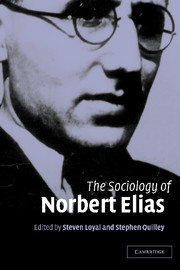Book contents
- Frontmatter
- Contents
- List of contributors
- Acknowledgements
- 1 Towards a ‘central theory’: the scope and relevance of the sociology of Norbert Elias
- Part I Sociology as a human science: Norbert Elias and the sociology of knowledge
- Part II Processes of stratification: figurations of race, class and gender
- 5 Aspects of the figurational dynamics of racial stratification: a conceptual discussion and developmental analysis of black–white relations in the United States
- 6 Decivilizing and demonizing: the remaking of the black American ghetto
- 7 Elias on class and stratification
- 8 Elias on gender relations: the changing balance of power between the sexes
- Part III The formation of individuals and states
- Part IV Religion and civilizing processes: Weber and Elias compared
- Index
- References
5 - Aspects of the figurational dynamics of racial stratification: a conceptual discussion and developmental analysis of black–white relations in the United States
Published online by Cambridge University Press: 22 September 2009
- Frontmatter
- Contents
- List of contributors
- Acknowledgements
- 1 Towards a ‘central theory’: the scope and relevance of the sociology of Norbert Elias
- Part I Sociology as a human science: Norbert Elias and the sociology of knowledge
- Part II Processes of stratification: figurations of race, class and gender
- 5 Aspects of the figurational dynamics of racial stratification: a conceptual discussion and developmental analysis of black–white relations in the United States
- 6 Decivilizing and demonizing: the remaking of the black American ghetto
- 7 Elias on class and stratification
- 8 Elias on gender relations: the changing balance of power between the sexes
- Part III The formation of individuals and states
- Part IV Religion and civilizing processes: Weber and Elias compared
- Index
- References
Summary
Introduction
The sociological problem considered in this chapter is ostensibly simple. It is, why, after some four centuries of oppression by whites, should blacks in the United States have begun to fight back openly and on a large scale only in the 1950s and 1960s? This is not to imply that American blacks failed totally to fight back before that period but rather to suggest that the civil rights movement and the urban riots of that era marked a watershed regarding the openness, scale and organization of their struggle against white domination. The fact that the slogan ‘black is beautiful’ was coined at the same time, suggests that this period also formed a turning point regarding the group consciousness of blacks, namely that they began in the 1950s and 1960s to have a more positive ‘we-image’ than hitherto. The point is to explain why this constellation of interrelated changes occurred and why the 1950s and 1960s represented a critical juncture in this process.
In approaching questions of this sort, it became conventional in sociology in the 1960s and 1970s to use variants of class and stratification theory (Kahl 1961; Marx 1969; Blauner 1972). I do not wish to deny the utility of this convention. It certainly helped to push the understanding of ‘race’ relations beyond the level possible within the largely psychological framework of ‘prejudice’ and ‘discrimination’ theories which had hitherto prevailed (Allport 1954).
- Type
- Chapter
- Information
- The Sociology of Norbert Elias , pp. 75 - 94Publisher: Cambridge University PressPrint publication year: 2004
References
- 9
- Cited by



